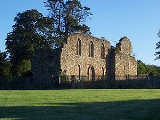
Kerelaw Castle
Encyclopedia
Kerelaw Castle is a castle
ruin situated on the coast of North Ayrshire
, Scotland
in the town of Stevenston
.
to have been held by the Lockharts from Richard de Morville
, Constable of Scotland, as far back as 1191, after Stephen Lockhart or Loccard obtained a grant of land in Ayrshire. This land would be named Stevenstoune (later Stevenston
) after himself, and their manor-place of the barony of Stevenston, named Kerelaw. The castle and barony were eventually passed on to the Campbells of Loudoun and later to the Cunninghames
(or Cunninghams/Cuninghames) of Kilmaurs
. It was in the Cunninghame's possession in 1488 that the castle was sacked and burned by the Earl of Eglinton
, a Montgomerie, during the well documented and long-term feud between these two prominent Ayrshire families. The Cunninghames, led by the Earl of Glencairn burned Eglinton Castle
to the ground in revenge in 1528.
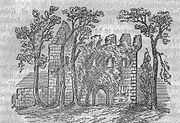 Kerelaw was rebuilt sometime after 1488 and is reported to have contained a number of carved coats of arms of the Scottish nobility, taken from Kilwinning Abbey
Kerelaw was rebuilt sometime after 1488 and is reported to have contained a number of carved coats of arms of the Scottish nobility, taken from Kilwinning Abbey
, Nine fishermen from Saltcoats
were granted leases in 1545 in return for carrying the Earl's furniture to Finlayston on the Clyde every spring from the Creek of Saltcoats and bringing it back again in the autumn when the family returned to Kerelaw for the winter months. A half barrel of herrings was also to be furnished yearly to the Earl.
of Kilwinning
, which may have arisen from the fact that the third son of Alexander Cunningham, 1st Earl of Glencairn
, became the Commendator of the abbey after the reformation and may have lived at Kerelaw.
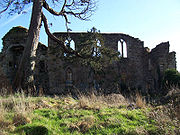
 In 1609 it was bought by Sir Thomas Boyd and soon after sold again to Sir William Cunninghame of Cunninghamhead
In 1609 it was bought by Sir Thomas Boyd and soon after sold again to Sir William Cunninghame of Cunninghamhead
. Thirty years later the castle and the nearby lands were bought by Sir Robert Cunninghame of Auchenharvie. In 1655 Kerelaw Castle was purchased by John Hamilton, formerly of Cambuskeith (now known as 'The Mount'), and afterwards of Grange (grandfather of Alexander Hamilton
), who changed the name of the castle and its grounds to Grange, after the family home in Kilmarnock
. Clements and Graham give the date of 1685 for the sale of Kerila (Kerelaw) to John Hamilton. The castle became the residence of the Hamilton family until 1787 when another Alexander Hamilton (second cousin of the American politician), built Kerelaw (or Grange) House
nearby, with the castle quickly becoming disused.
The foundation stone of the new Eglinton Castle
in Kilwinning was laid in 1797 by Alexander Hamilton of Grange on behalf of the 12th Earl of Eglinton.

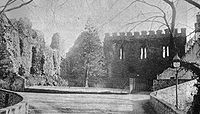 A dovecote
A dovecote
or doocot dated 1775 existed here (see illustration) until the 1960s when it was demolished together with other outbuildings. Cottages for the workpeople had been built in the court of the castle, and their high corbie-stepped gable-ends added to the picturesque effect of the castle ruins. The gothic windows may be one of the 19th century additions to the buildings. A limekiln was also situated nearby at NS 2706 4309. Dudups (Diddup) nearby was part of the Kerelaw/Grange Estate.
Roy's Survey map of 1747 records the name as Kerry-law, and Smith refers to it as Kerila Castle; as does Paterson. Kyryaw castle, mains and mill are marked on Ponts map of 1604 - 1608. A lodge house, situated to the east of the castle is marked on the older OS maps
and is still in existence today (2008) as a private home.
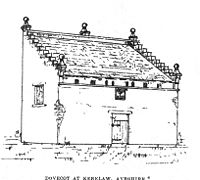 Kerelaw Castle is now a ruin, with three walls surviving in various states of decay. Gothic windows still adorn the southern wall, believed to have been inspired by those at Kilwinning Abbey
Kerelaw Castle is now a ruin, with three walls surviving in various states of decay. Gothic windows still adorn the southern wall, believed to have been inspired by those at Kilwinning Abbey
(and are proof that much of the castle was built at various points in history).
In 1852 Paterson noted arrow-slits and cable mouldings of pre-14th century date. An ancient footbridge is situated next to the ruin (NS 2688 4288) and is still intact and walkable, but the castle itself is fenced off to protect both the public from falling stone and the castle from vandalism. The castle and surrounding ground is owned by North Ayrshire Council.
The castle's former walled garden is now occupied by a housing estate built in the late 1960s, but a single wall of the structure still remains.
Castle
A castle is a type of fortified structure built in Europe and the Middle East during the Middle Ages by European nobility. Scholars debate the scope of the word castle, but usually consider it to be the private fortified residence of a lord or noble...
ruin situated on the coast of North Ayrshire
North Ayrshire
North Ayrshire is one of 32 council areas in Scotland with a population of roughly 136,000 people. It is located in the south-west region of Scotland, and borders the areas of Inverclyde to the north, Renfrewshire to the north-east and East Ayrshire and South Ayrshire to the East and South...
, Scotland
Scotland
Scotland is a country that is part of the United Kingdom. Occupying the northern third of the island of Great Britain, it shares a border with England to the south and is bounded by the North Sea to the east, the Atlantic Ocean to the north and west, and the North Channel and Irish Sea to the...
in the town of Stevenston
Stevenston
Stevenston is a town in North Ayrshire, Scotland. It is one of the 'Three Towns' along with Ardrossan and Saltcoats.-History:The town is named after Stephan Loccard or Lockhart, whose father obtained a grant of land from Richard de Morville, Lord Cunninghame and Constable of Scotland, around 1170....
.
History
This castle, variously named Kerelaw, Kerila or even Turnlaw, is said by Timothy PontTimothy Pont
Timothy Pont was a Scottish topographer, the first to produce a detailed map of Scotland. Pont's maps are among the earliest surviving to show a European country in minute detail, from an actual survey.-Life:...
to have been held by the Lockharts from Richard de Morville
Richard de Morville
Richard de Morville , succeeded his father Hugh de Morville as Constable of Scotland and in his Scottish estates and English lands at Bozeat in Northamptonshire, and Rutland, as well as a number of feus of the Honour of Huntingdon....
, Constable of Scotland, as far back as 1191, after Stephen Lockhart or Loccard obtained a grant of land in Ayrshire. This land would be named Stevenstoune (later Stevenston
Stevenston
Stevenston is a town in North Ayrshire, Scotland. It is one of the 'Three Towns' along with Ardrossan and Saltcoats.-History:The town is named after Stephan Loccard or Lockhart, whose father obtained a grant of land from Richard de Morville, Lord Cunninghame and Constable of Scotland, around 1170....
) after himself, and their manor-place of the barony of Stevenston, named Kerelaw. The castle and barony were eventually passed on to the Campbells of Loudoun and later to the Cunninghames
Earl of Glencairn
The title of Earl of Glencairn was created in the Peerage of Scotland in 1488 for the first Lord Kilmaurs .On the death of the fifteenth earl in 1796, there existing no original Letters Patent of the creation nor a given remainder in the various confirmations in title of previous earls the title...
(or Cunninghams/Cuninghames) of Kilmaurs
Kilmaurs
Kilmaurs is a village in East Ayrshire, Scotland. It lies on the Carmel, 21.1 miles south by west of Glasgow. Population recorded in 2001 Census, 2601- History :...
. It was in the Cunninghame's possession in 1488 that the castle was sacked and burned by the Earl of Eglinton
Earl of Eglinton
Earl of Eglinton is a title in the Peerage of Scotland.Some authorities spell the title: Earl of Eglintoun In 1859 the thirteenth Earl of Eglinton, Archibald Montgomerie, was also created Earl of Winton in the Peerage of the United Kingdom, which gave him an automatic seat in the House of Lords,...
, a Montgomerie, during the well documented and long-term feud between these two prominent Ayrshire families. The Cunninghames, led by the Earl of Glencairn burned Eglinton Castle
Eglinton Castle
Eglinton Castle was a large Gothic castellated mansion in Kilwinning, North Ayrshire, Scotland.-The castle :The ancient seat of the Earls of Eglinton, it is located just south of the town of Kilwinning...
to the ground in revenge in 1528.

Kilwinning Abbey
Kilwinning Abbey is a ruined abbey located in the centre of the town of Kilwinning, North Ayrshire.-The establishment of the Abbey:The ancient name of the town is 'Segdoune' or 'Saigtown', probably derived from 'Sanctoun', meaning the 'town of the saint'. Saint Winnings festival was on 21 January...
, Nine fishermen from Saltcoats
Saltcoats
- References :*McSherry, R. & M. . Old Saltcoats, Stenlake Publishing, Ochiltree. ISBN 1-872074-57-X.*Stansfield, G. . Ayrshire & Renfrewshire's Lost Railways, Stenlake Publishing, Catrine. ISBN 1-84033-077-5.-External links:***...
were granted leases in 1545 in return for carrying the Earl's furniture to Finlayston on the Clyde every spring from the Creek of Saltcoats and bringing it back again in the autumn when the family returned to Kerelaw for the winter months. A half barrel of herrings was also to be furnished yearly to the Earl.
Abode of the Abbots
Local tradition is that the castle had been the residence of the AbbotAbbot
The word abbot, meaning father, is a title given to the head of a monastery in various traditions, including Christianity. The office may also be given as an honorary title to a clergyman who is not actually the head of a monastery...
of Kilwinning
Kilwinning
Kilwinning is a historic town in North Ayrshire, Scotland. It is known as The Crossroads of Ayrshire. The 2001 Census recorded it as having a population of 15,908.-History:...
, which may have arisen from the fact that the third son of Alexander Cunningham, 1st Earl of Glencairn
Alexander Cunningham, 1st Earl of Glencairn
Alexander Cunningham, 1st Earl of Glencairn, 1st Lord Kilmaurs was a Scottish nobleman.He was firstly created a Lord of Parliament in 1450, with the title Lord Kilmaurs....
, became the Commendator of the abbey after the reformation and may have lived at Kerelaw.

Later history

Cunninghamhead
Cunninghamhead is a hamlet in North Ayrshire, Scotland. It was the centre of the lands of Cunninghamhead, Perceton and Annick Lodge in Cunninghame...
. Thirty years later the castle and the nearby lands were bought by Sir Robert Cunninghame of Auchenharvie. In 1655 Kerelaw Castle was purchased by John Hamilton, formerly of Cambuskeith (now known as 'The Mount'), and afterwards of Grange (grandfather of Alexander Hamilton
Alexander Hamilton
Alexander Hamilton was a Founding Father, soldier, economist, political philosopher, one of America's first constitutional lawyers and the first United States Secretary of the Treasury...
), who changed the name of the castle and its grounds to Grange, after the family home in Kilmarnock
Kilmarnock
Kilmarnock is a large burgh in East Ayrshire, Scotland, with a population of 44,734. It is the second largest town in Ayrshire. The River Irvine runs through its eastern section, and the Kilmarnock Water passes through it, giving rise to the name 'Bank Street'...
. Clements and Graham give the date of 1685 for the sale of Kerila (Kerelaw) to John Hamilton. The castle became the residence of the Hamilton family until 1787 when another Alexander Hamilton (second cousin of the American politician), built Kerelaw (or Grange) House
Kerelaw House
Kerelaw House was part of the former Kerelaw Estate situated on the west coast of Ayrshire, Scotland near the town of Stevenston.- History :...
nearby, with the castle quickly becoming disused.
The foundation stone of the new Eglinton Castle
Eglinton Castle
Eglinton Castle was a large Gothic castellated mansion in Kilwinning, North Ayrshire, Scotland.-The castle :The ancient seat of the Earls of Eglinton, it is located just south of the town of Kilwinning...
in Kilwinning was laid in 1797 by Alexander Hamilton of Grange on behalf of the 12th Earl of Eglinton.

Ancillary buildings

Dovecote
A dovecote or dovecot is a structure intended to house pigeons or doves. Dovecotes may be square or circular free-standing structures or built into the end of a house or barn. They generally contain pigeonholes for the birds to nest. Pigeons and doves were an important food source historically in...
or doocot dated 1775 existed here (see illustration) until the 1960s when it was demolished together with other outbuildings. Cottages for the workpeople had been built in the court of the castle, and their high corbie-stepped gable-ends added to the picturesque effect of the castle ruins. The gothic windows may be one of the 19th century additions to the buildings. A limekiln was also situated nearby at NS 2706 4309. Dudups (Diddup) nearby was part of the Kerelaw/Grange Estate.
Roy's Survey map of 1747 records the name as Kerry-law, and Smith refers to it as Kerila Castle; as does Paterson. Kyryaw castle, mains and mill are marked on Ponts map of 1604 - 1608. A lodge house, situated to the east of the castle is marked on the older OS maps
Ordnance Survey
Ordnance Survey , an executive agency and non-ministerial government department of the Government of the United Kingdom, is the national mapping agency for Great Britain, producing maps of Great Britain , and one of the world's largest producers of maps.The name reflects its creation together with...
and is still in existence today (2008) as a private home.
Later history
The house, the castle and the grounds were all sold in 1838 to Gavin Fullerton after Alexander's death. Fullerton soon restored the original name of Kerelaw.The castle today

Kilwinning Abbey
Kilwinning Abbey is a ruined abbey located in the centre of the town of Kilwinning, North Ayrshire.-The establishment of the Abbey:The ancient name of the town is 'Segdoune' or 'Saigtown', probably derived from 'Sanctoun', meaning the 'town of the saint'. Saint Winnings festival was on 21 January...
(and are proof that much of the castle was built at various points in history).
In 1852 Paterson noted arrow-slits and cable mouldings of pre-14th century date. An ancient footbridge is situated next to the ruin (NS 2688 4288) and is still intact and walkable, but the castle itself is fenced off to protect both the public from falling stone and the castle from vandalism. The castle and surrounding ground is owned by North Ayrshire Council.
The castle's former walled garden is now occupied by a housing estate built in the late 1960s, but a single wall of the structure still remains.

